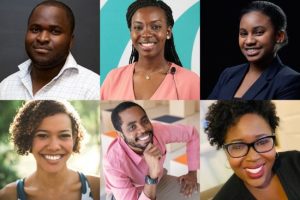
Kelly-Marie Melville (ChemE 1T2 + PEY) was in her dorm room, just two weeks into her studies at U of T Engineering, when a fellow student Korede Owolabi (CompE 1T5 + PEY) and member of the National Society of Black Engineers (NSBE) U of T chapter came knocking on her door.
“He gave me a full rundown about NSBE, and I didn’t fully understand the gravity of it at the time,” says Melville. “But once I started my classes, I got it.”
Melville remembers sitting in Convocation Hall, where all first-year engineering students traditionally gather for their first class together.
“It was intimidating for someone who just moved here from Trinidad and for someone who is just starting engineering. I remember thinking, ‘oh my goodness, there is no one here who looks like me.’”
NSBE, founded in 1975 at Purdue University, aims to promote, support and increase the number of Black engineers who excel academically and professionally. Each year, the NSBE National Convention brings thousands of members together for networking and professional development opportunities. The organization’s goal is to graduate 10,000 Black engineers annually by 2025.
The U of T chapter, founded in 1999, is the largest in Toronto. And for more than 20 years, NSBE U of T has played an important role in increasing Black inclusion at U of T, and in fostering a safe space among Black engineering students, who continue to be underrepresented among the student body.
Three years after that knock on the door, Melville was NSBE president (2009 to 2010), and found herself using the same recruitment strategy. “Sometimes I was even chasing students down in the hallways to talk to them [about NSBE],” she says.
One of the students she introduced NSBE to was Akira Neckles (ChemE 1T7 + PEY), who would also eventually become president (2016 to 2017). During her studies, Neckles remembers seeing only five Black students within her year.
“That can really make you feel like you don’t belong,” she says. “With NSBE, it felt like it brought us together. Within a program, we’re less, but within a group, we’re more.”
Over the years, each NSBE U of T president would bring a unique vision and leave their own legacy of impact.
During Melville’s term, she worked to significantly increase NSBE U of T memberships. For Neckles, her focus was on professional development, inviting organizations to U of T so that members were informed of career pathways, even before looking ahead at their Professional Experience Year (PEY) Co-op.
During Dimpho Radebe’s (IndE 1T4 + PEY, ChemE PhD candidate in EngEd ) presidency (2014 to 2015), she was challenged with keeping NSBE U of T afloat, as memberships began to dwindle.
“I think the biggest challenge for NSBE is that, although it is an organization created to support Black students, we’ve always said, we’re open to everyone and not exclusively to Black students,” explains Radebe. “But many students don’t realize that, and it makes our potential pool that much smaller.”
Radebe says one of her greatest achievements during her leadership was sending 10 students to the NSBE National Convention in Anaheim, Calif.
“That experience really inspired students to join because they can see the full power of NSBE versus when you don’t see many of us around at school,” she says. “Many of them ended up running for leadership positions after that.”
For Iyiope Jibodu (ChemE 0T8 + PEY), it was about “NSBE family and NSBE love.” As president from 2008 to 2009, he was instrumental in launching D-Battle, a student dance competition that would attract large crowds to the Sandford Fleming atrium. D-Battle started as an idea by Owolabi to increase membership — the event would become a staple NSBE event for years to come.
“NSBE had a reputation as a professional student group, but we took the risk to host D-Battle, which turned out to be a fantastic platform to increase awareness on campus,” says Jibodu. “By having a fun event with mass appeal, we brought the entire Faculty together and showcased our strong and vibrant community.”
During Mikhail Burke’s (MSE 1T2, IBBME PhD 1T8) presidency (2010 to 2011), he would play a pivotal role in founding ENGage, an outreach program for Black students in Grades 3 to 8 that sparks passion for STEM (science, technology, engineering and math). ENGage has been running for more than a decade out of the U of T Engineering Outreach Office, and would pave the way for Blueprint, a new program designed for Black high school students interested in STEM.
Alana Bailey (Year 3 CivMin) is NSBE U of Ts current president and has had a term like no other — having to lead from home during the pandemic. Despite this challenge, Bailey has set out ambitious goals.

Her mission when she took office in May was to have each executive member recruit at least five students — this led to a growth of more than 60 members by September 2020. Under her leadership, NSBE U of T has been more involved in Faculty recruitment events, as well as leading their own high school outreach efforts.
This year, NSBE U of T has also brought in more external sponsors to support initiatives — most recently, NSBEHacks garnered a wide range of sponsorships with leading companies such as Google, NVIDIA and Shopify, just to name a few.
Bailey hopes this effort builds toward retaining sponsorships year-round, providing funds for members pursuing professional development endeavours.
“If students need help to go to a conference or to enrol in an expensive course, our hope is to have the supports to actively help them achieve that,” says Bailey.
Bailey has three months left in her term, before she takes up her PEY Co-op position next fall. She plans to stay in close contact with NSBE, and she isn’t alone in wanting to stay in touch — many former presidents and members continue to advise, mentor and participate in NSBE U of T events.
That includes Burke, who is now the Dean’s Advisor on Black Inclusivity Initiatives and Student Inclusion & Transition Advisor at U of T Engineering. Over the last decade, he has seen and participated in many efforts by U of T Engineering to address Black underrepresentation — and NSBE has always played a role.
“There’s been a shift in what the Faculty feels empowered to do and it’s a good start, but there’s always room to do more. We have to continue to lean into the discomfort of talking about the lack of Black representation and about anti-Black racism on campus,” he says. “Organizations like NSBE are key advocates in driving the Faculty to engage in that change.”
By: Liz Do
This story originally published by Engineering News
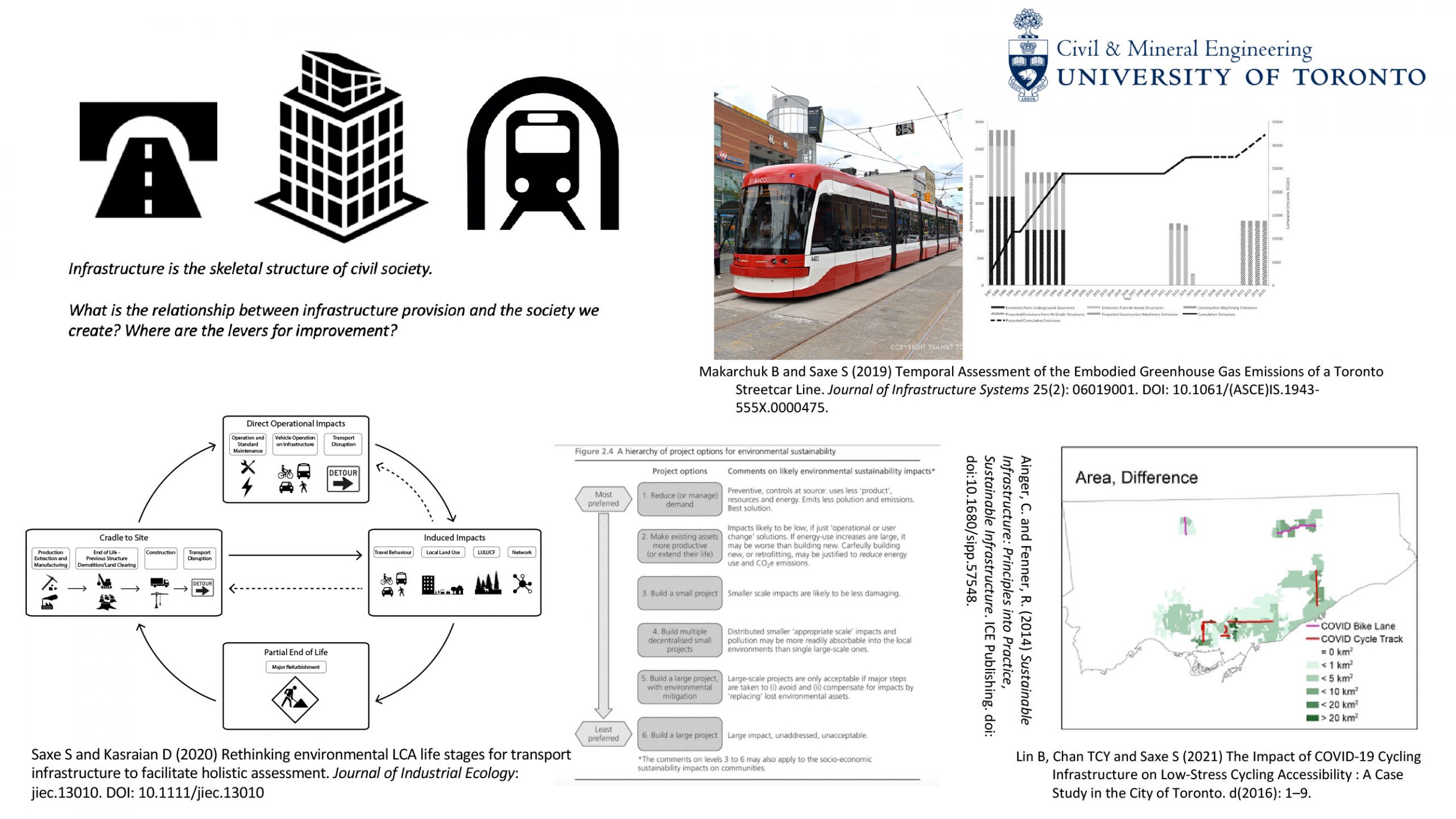
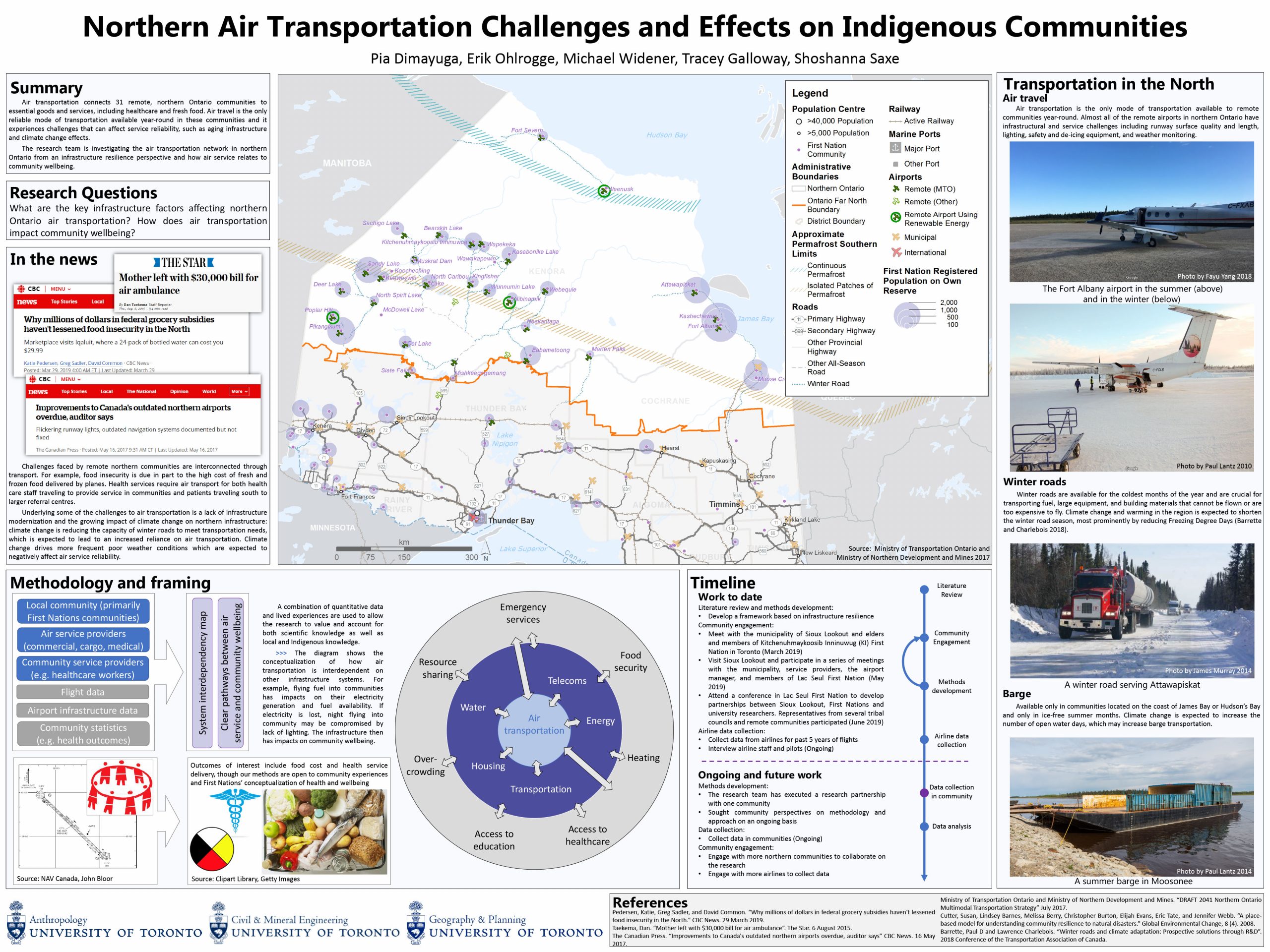

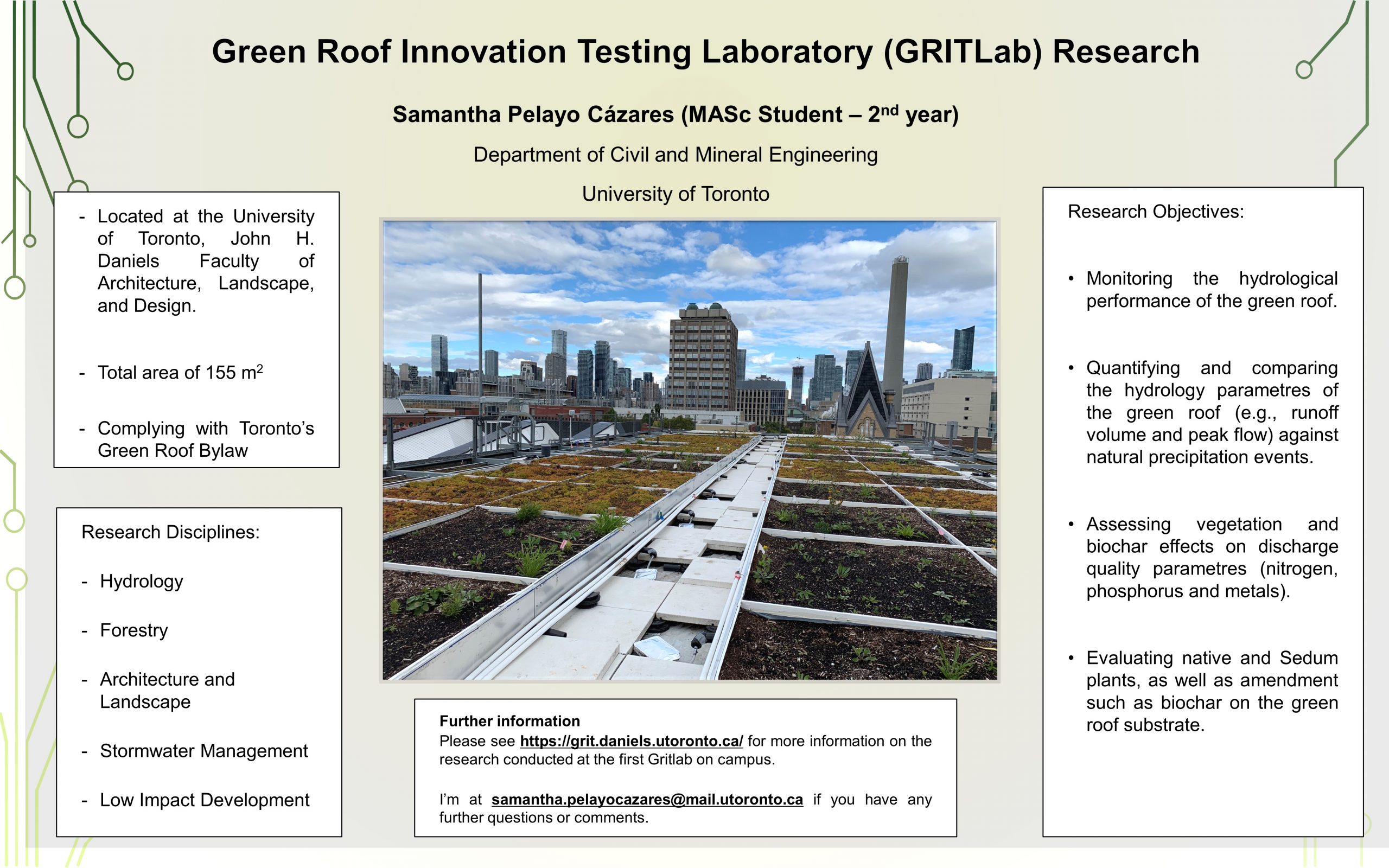
February 10, 2021 | The Washington Post
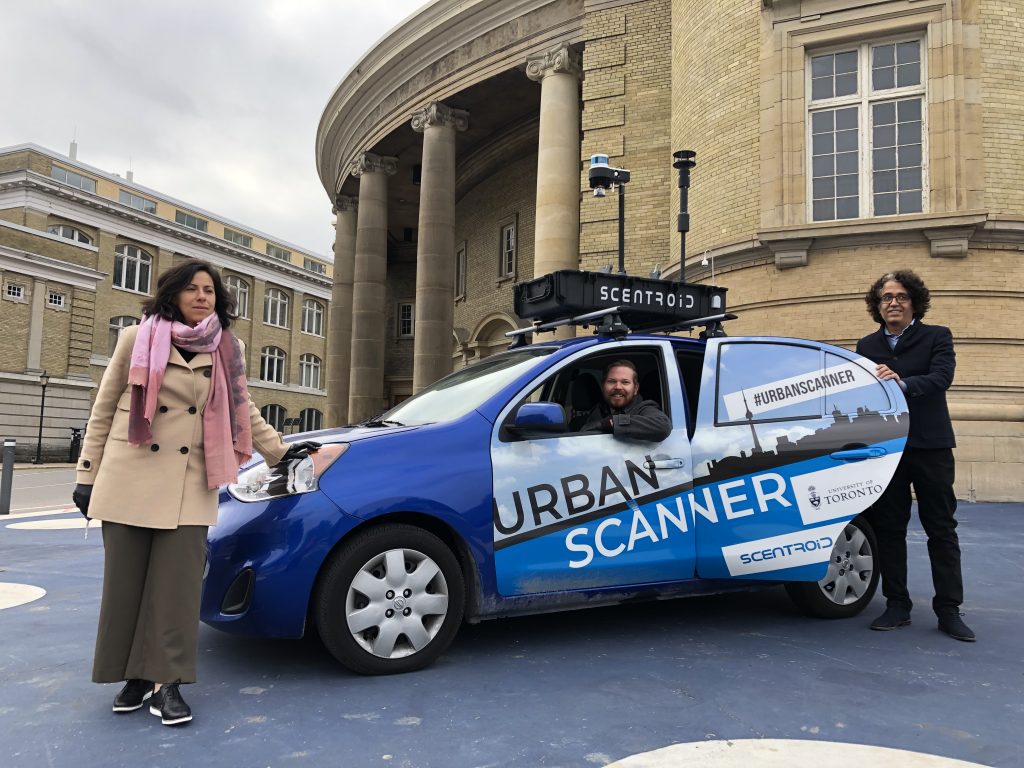
What rolls around the city getting a lot of admiring looks for its flashy chromed finishes and high tech roof protrusions? It’s not the latest tech from a popular web search engine company; it’s something entirely different. Meet UrbanScanner, a mobile testing laboratory on wheels, in the form of an automobile, researchers are driving around Toronto to monitor air pollution.
The Transportation and Air Quality (TRAQ) research group within the Department of Civil & Mineral Engineering at U of T, led by Prof. Marianne Hatzopoulou, has partnered with Scentroid, a Toronto-based company developing sensor-based systems for urban air pollution monitoring. The result is the development of UrbanScanner.
Hatzopoulou’s team, comprised of research associate Arman Ganji, PhD and Keni Mallinen, an MASc candidate, has been getting a lot of looks while gathering their data, but little is known about this mysteriously well-equipped rolling lab.
Watch an introductory video:
With a 360-degree camera, LIDAR (Light Detection and Ranging), GPS, an ultrasonic anemometer, temperature and relative humidity sensors, as well as particulate matter and gas sensors, UrbanScanner can monitor air pollution in a variety of methods. A platform on the roof of the vehicle streams data to a cloud server, with air pollution measured every second and paired with the camera and LIDAR images.
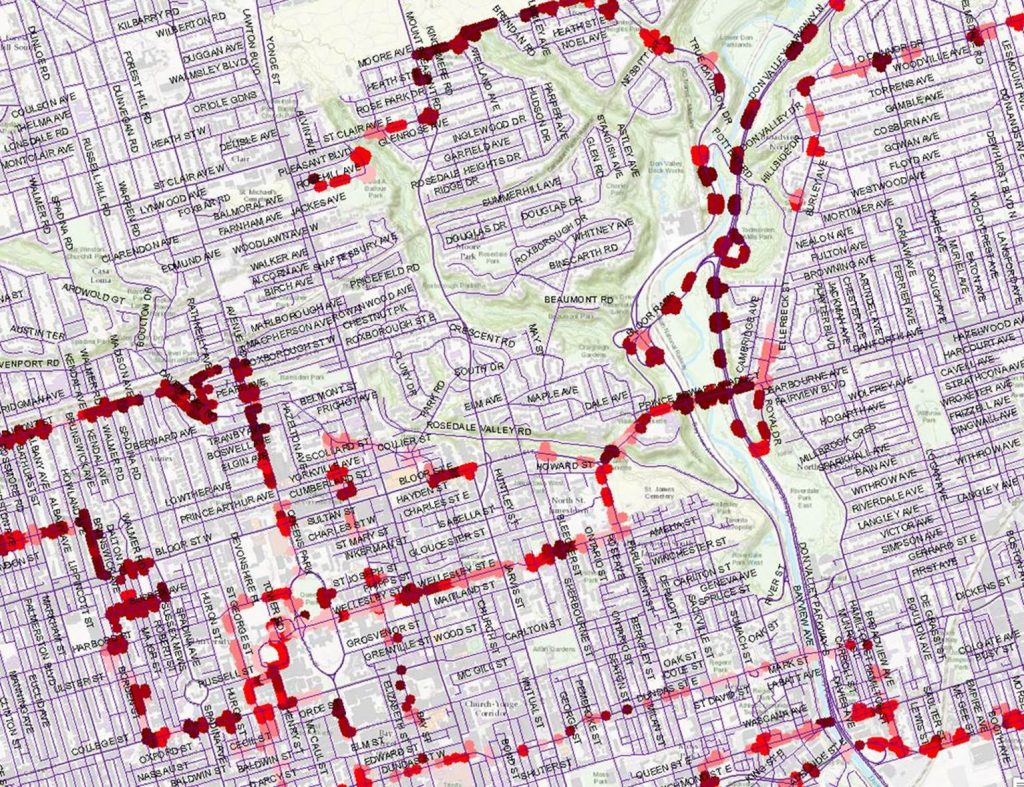
Besides air quality, the traffic, trees and built environment are constantly measured. All of the data is overlaid over city maps with the aid of GPS, allowing for real-time measurements of traffic flow, number and height of trees, as well as building forms. With the ability to measure air flow and pollution near built-up urban areas, the maps can reveal elevated pollution levels, especially at rush hour and depending upon the season.
All of the data collected thus far takes time and effort to process, but Hatzopoulou has plans going forward. “Since September 2020, UrbanScanner has been collecting air quality data across Toronto, both along major roads and within Toronto neighbourhoods,” she says. “These data were paired with images of the urban environment from the UrbanScanner camera and these images will be analyzed to extract important features that affect air quality. This massive database will continue to grow as UrbanScanner collects data across seasons and will help us predict air quality in space and time, providing crucial information about population exposures in the City.”
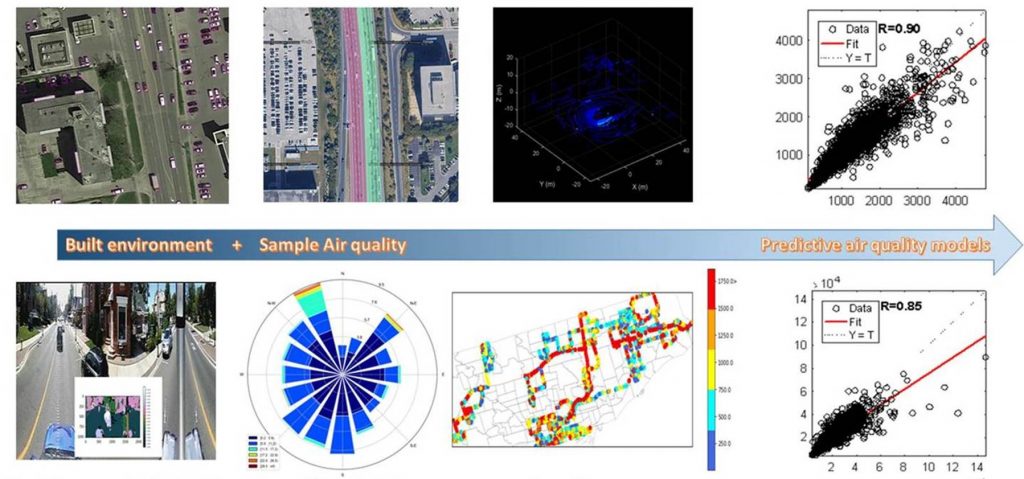
Hatzopoulou adds, “Our team is also working on a smaller, more compact version of UrbanScanner with multiple units that will be installed on commercial/delivery vehicles. Imagine a dozen UrbanScanners collecting data simultaneously every day in Toronto!”
The research team is also developing a website to share data from the UrbanScanner project with the public and working on ways to enhance public engagement around urban air quality.
So, now if you see UrbanScanner in your neighbourhood you’ll know exactly what the team is up to. Please feel free to take a snap and tag #UrbanScanner and @CivMin.
By Phill Snel
By the numbers:
~250,000 • Number of data points collected in a month.
2,280 • Kilometres driven in a month of study.
101 • Hours of collection data.
60 • Kilometres driven each day of monitoring.
14 • Sensors on UrbanScanner.
4 • Wheels.
3 • Researchers.
2 • Seats in UrbanScanner.
1 • Mobile laboratory platform.
~ CivMin ~
Watch a detailed, technical tour of UrbanScanner from Scentroid:
In celebration of International Day of Women and Girls in Science on Feb. 11, we asked some of the amazing women within the Department of Civil & Mineral Engineering to reflect on what it means to be a woman in Engineering/STEM.
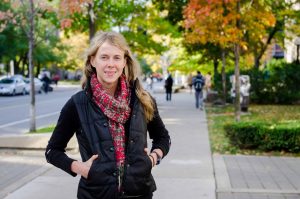
Meet Donna Vakalis, a Civil Engineering PhD whose research examines how energy retrofits impact building occupants - in terms of their comfort, health or performance. Donna believes we need to make buildings more energy-efficient while also improving buildings overall - thinking in terms of how buildings impact the quality of our daily activities (working, learning, sleeping etc.).
"Honestly, it makes me happy to look around and see change happening in real time."
What does it mean to you to be a woman in Engineering/STEM?
Honestly, it makes me happy to look around and see change happening in real time. For instance, I see more women professors in engineering and more women on professional panels in the engineering industry.
Do you have a message for girls considering pursuing an education/career in Engineering/STEM?
I moved away from engineering/STEM mid-way through my undergraduate degree, even though math and physics were my favourite courses. I felt like there was this broader unsympathetic attitude toward social justice in the STEM field and I (mistakenly) decided that I needed to choose between social justice issues OR engineering! I have learned a lot since then. I want everyone, girls/guys/everyone, to know that Engineering is not incompatible with broader social justice work. In fact, we need people who are trained to think rigorously in both of these dimensions.
______
Meet Sarah Kumar, a fourth year Mineral Engineering student who focuses on the environmental side of mining. Sarah hopes to help advance environmental monitoring and mitigation practices to help create a more sustainable industry.
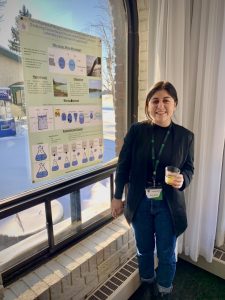
"I hope to see women continue to advance engineering and STEM fields by adding their unique perspective on problems."
What does it mean to you to be a woman in Engineering/STEM?
Being a woman in engineering is about being myself and pursing my passions. It means working together with different people with diverse skillsets to overcome problems and make things better.
What would you like to see in the future for women in Engineering/STEM?
I hope to see women continue to advance engineering and STEM fields by adding their unique perspective on problems. Our continued contribution will allow for faster advancements on research and technology to create a safer and more sustainable planet.
Do you have a message for girls considering pursuing an education/career in Engineering/STEM?
Engineering and STEM fields open a wide variety of opportunities that can allow you to explore many different paths. These fields offer the opportunity to have a very unique career while still being fulfilling and stable.
______
Meet Mahia Anhara, a Civil Engineering student currently doing her PEY in the Vision Zero Projects Unit at the City of Toronto. Mahia is particularly interested in the field of transportation so she can help provide improved transit access and safer streets for cyclists and pedestrians.

"I am grateful to the women who were brave enough to go against societal norms and expectations to follow their passion for engineering."
What does it mean to you to be a woman in Engineering/STEM?
I am grateful to the women who were brave enough to go against societal norms and expectations to follow their passion for engineering. Many of them walked the difficult path of being the only women in their engineering classes and workplaces and facing outright discrimination. Because of the women in engineering before me, I can pursue my passion without my gender becoming a limiting factor. As a woman in engineering, I want to continue the legacy of the courageous women and help promote engineering to girls.
What would you like to see in the future for women in Engineering/STEM?
I would like to see more women in leadership positions in the engineering field. Engineers play a huge role in the functioning of society and to meet the needs of a diverse population. Women are half the population but are very underrepresented in the engineering field. More women in engineering leadership can help bring alternative perspectives and experiences of navigating the world. This would lead to better informed decisions that reflect the needs of our diverse population.
Do you have a message for girls considering pursuing an education/career in Engineering/STEM?
Engineering is more than solving math and science problems. The work that engineers do can make a positive difference in people’s lives and has the power to tackle global problems such as climate change and poverty. If you have a desire to improve our society, engineering is one of the most impactful ways of doing so!
______
Meet Chibulu (Lulu) Luo, a Civil Engineering PhD Candidate. Lulu uses her engineering skills to address global sustainability challenges and contribute to projects that help drive investments for sustainable infrastructure in developing countries. She has worked extensively in international contexts with institutions such as the World Bank and the United Nations. She has conducted research in Tanzania, Zambia, Rwanda, and Ghana, as part of her PhD work.
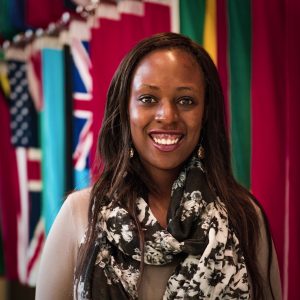
"Being a woman of colour and of African descent, I am proud and honoured for the opportunity to inspire young girls who may look like me to say, 'Yes, I can do that too!'"
What does it mean to you to be a woman in Engineering/STEM?
Being a woman of colour and of African descent, I am proud and honoured for the opportunity to inspire young girls who may look like me to say, "Yes, I can do that too!". The sad reality of our world is that young girls of colour may not see themselves represented in engineering and STEM fields - therefore am always happy to share my experience and the exciting opportunities that the engineering profession can bring!
What would you like to see in the future for women in Engineering/STEM?
I would love to see more diversity in Engineering and STEM. Not just the inclusion of women, but women of all backgrounds, races, and creeds.
Do you have a message for girls considering pursuing an education/career in Engineering/STEM?
We need more girls like you in engineering. You are talented and smart and can bring a different and unique perspective to the challenging and interesting work that we do as engineers!
______
Meet Stephanie Marton, a fourth year Civil Engineering student who is pursuing a minor in Environmental Engineering, a certificate in Global Engineering and a certificate in Business, Innovation and Entrepreneurship. Stephanie has a keen interest in Goal 11 of the Sustainable Development Goals (SDGs) - Sustainable Infrastructure and Communities. She hopes to play a key role in shaping local and global community infrastructure in a sustainable and forward-thinking way throughout her future career.

"Being a woman in STEM helps eliminate the idea that STEM is a male dominated field and empowers me to make a positive impact in our world!"
What does it mean to you to be a woman in Engineering/STEM?
Being a woman in STEM helps eliminate the idea that STEM is a male dominated field and empowers me to make a positive impact in our world!
Every engineer has a duty to society; being in this program constantly reminds me of the significant impact and influence I can have in making our world a better place for ALL. I have had motivating and satisfying experiences in my studies and work in engineering, especially knowing that what I am doing can shape our societies in a beneficial way - a truly empowering feeling!
What would you like to see in the future for women in Engineering/STEM?
No limitations.
I aspire to see a future where everyone is committed and working together to unlock each other's potential. The Sustainable Development Goals (SDGs) set out by the United Nations provide a great framework to achieve a sustainable and equitable world for all. We need a diverse set of hands on deck for developing innovative ways to accomplish these goals! I would love for women to play a large role in making that happen. As an engineer who has worked in the field and is very passionate about construction, I am looking forward to seeing women continue to flourish in this industry.
Do you have a message for girls considering pursuing an education/career in Engineering/STEM?
Go for it! Be the change you want to see in the world.
Especially in engineering, what you choose to do in your studies and career can make a meaningful impact on the world. If you are open to learning and taking on challenges in an innovative way, your motivation and determination will lead you to be boundless in your contributions! I thrive on pushing myself out of my comfort zone to grow and learn as a professional; I highly encourage other women to do the same! I, along with many others in STEM, am happy to support you in your journey.
______
Meet Kelsey Smyth, a PhD candidate studying stormwater management and low impact development, otherwise known as green infrastructure. Green infrastructure is used to manage flooding and improve water quality in urban areas. More specifically, Kelsey studies the use of bioretention cells or rain gardens for their capacity to capture microplastics and prevent their spread in the wider environment.
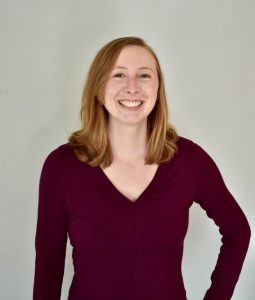
"I would like to see a continued increase in gender diversity in educational programs as well as in industry roles."
What does it mean to you to be a woman in Engineering/STEM?
I love that I get to explore never ending interesting issues and gain the satisfaction that comes from solving a problem. As a woman in Engineering, I am so fortunate to have pursued my studies in Canada at this time when a lot of progress has been made in equity and diversity in my discipline. I am extremely thankful to all the women in Engineering and STEM who paved the way for me and to all the amazing role models I've had including my mom as a woman in STEM who encouraged me and supported me in pursuing Engineering.
What would you like to see in the future for women in Engineering/STEM?
I would like to see a continued increase in gender diversity in educational programs as well as in industry roles. I would also like to see less bias regarding gender roles and perceived characteristics and for there to be more women in high level management but also technical positions.
Do you have a message for girls considering pursuing an education/career in Engineering/STEM?
I did not know what Engineering was before starting university. I chose it because I wanted a field that I found exciting, that would challenge me and that could allow me to make a meaningful impact to society. If you are similarly interested a field where you get to explore and solve new problems, then Engineering is a great field to pursue.
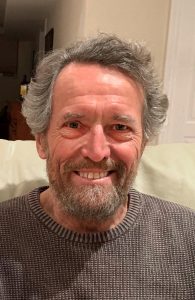
Professor Jeffrey Packer is to receive a Lifetime Achievement Award from the American Institute of Steel Construction (AISC). He is among 12 named for recognition by the organization.
According to the AISC announcement, “AISC awards recognize individuals who have made a significant difference in the success of the fabricated structural steel industry. Whether it’s for an innovative design, an insightful technical paper, or a lifetime of outstanding service, an AISC award bestows prestige and well-deserved recognition upon its recipient. The Lifetime Achievement Award honors (sic) individuals whose continued outstanding service has made a difference in the success of AISC, the structural steel industry, and the structural steel design, construction, and academic communities.”
The recognition for Prof. Packer reads as:
Jeffrey Packer is one of the leading researchers and foremost experts on tubular steel structures in the world. In his 40-year career at the University of Toronto, he has conducted groundbreaking research on tubular steel members, connections, and structures and has published extensively on these topics, including numerous books and design guides. His work has significantly advanced both the state-of-the-art and the state-of-the-practice in tubular steel construction. His work has also had a major impact on design standards for tubular steel structures, including those in the AISC Specification for Structural Steel Buildings.
Packer served on AISC task committees that developed the Specification for the Design of Steel Hollow Structural Sections and has served on AISC Task Committee 6–Connection Design since 2002. In 2005, Packer received an AISC Special Achievement Award for his work on tubular structures. In addition to Canadian and international technical committees, he has also served as a member of the American Welding Society D1.1 Committees on Design (TG1) and Tubulars (TG7). The result of his work has had a profound and sustained impact on the structural steel industry.
February 5, 2021 | CBC Marketplace